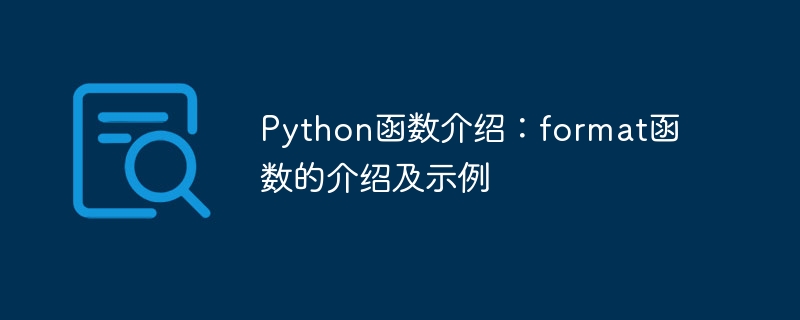Home >Backend Development >Python Tutorial >Introduction to Python functions: introduction and examples of format function
Introduction to Python functions: introduction and examples of format function
- WBOYWBOYWBOYWBOYWBOYWBOYWBOYWBOYWBOYWBOYWBOYWBOYWBOriginal
- 2023-11-03 10:45:161314browse

Introduction to Python functions: introduction and examples of format function
In Python, the format() function is a very important and commonly used function. It is used to format characters. The string is formatted. Through the format() function, we can splice some variables, data and text together in a certain format and output them into the string we want.
The syntax of the format() function is as follows:
string.format(arg1, arg2, ...)
Among them, string is the string that needs to be formatted, and arg1, arg2, etc. are variables or variables that need to be inserted into the string. data. The format() function can accept any number of parameters, which correspond to the positions of the curly braces {} in the string.
Now, let me demonstrate the usage of the format() function through several specific examples.
Example 1: Basic usage
name = "Alice"
age = 25
hobby = "coding"
message = "My name is {}, I am {} years old, and I love {}.".format(name, age, hobby)
print(message)The output result is:
My name is Alice, I am 25 years old, and I love coding.
In this example, we define three variables name, age and hobby, corresponding to arg1, arg2 and arg3 in the format() function respectively. Through the format() function, we insert these three variables into the string message to form the result we want.
Example 2: Formatting numbers
number = 3.1415926
message = "The value of pi is {:.2f}.".format(number)
print(message)The output result is:
The value of pi is 3.14.
In this example, we use the format of the format() function options to control the output format of numbers. {:.2f} indicates that the output floating point number retains two decimal places.
Example 3: Format string
first_name = "John"
last_name = "Doe"
message = "My name is {last}, {first} {last}.".format(first=first_name, last=last_name)
print(message)The output result is:
My name is Doe, John Doe.
In this example, we use the format() function Keyword parameters are used to specify the insertion position of the string, and the same parameter can also be used multiple times.
Example 4: Mixed use of index order and keyword arguments
name = "Alice"
age = 25
message = "My name is {0}, I am {1} years old, and I love {hobby}.".format(name, age, hobby="coding")
print(message)The output is:
My name is Alice, I am 25 years old, and I love coding.
In this example, we mix The index order and keyword parameters are used to specify the insertion position of the string. The index order is represented by {0} and {1}, and the keyword parameters are represented by {hobby}.
Summary:
The format() function is a very practical string formatting function, which is very convenient when processing strings. We can use the format() function to splice variables, data and text into the output we want. Whether it is basic usage, formatting numbers or formatting strings, the format() function can meet our needs well. I hope that through this article, I will have a certain understanding of the format() function and be able to use it flexibly in actual programming.
The above is the detailed content of Introduction to Python functions: introduction and examples of format function. For more information, please follow other related articles on the PHP Chinese website!
Related articles
See more- How to use the format function in formatted strings
- How to set the html5 border attribute? Introduction to the border attribute in html5 table
- How to center the content of html table table labels? Introduction to the usage of the align attribute of the table
- What is a java virtual machine? A brief introduction to JVM

